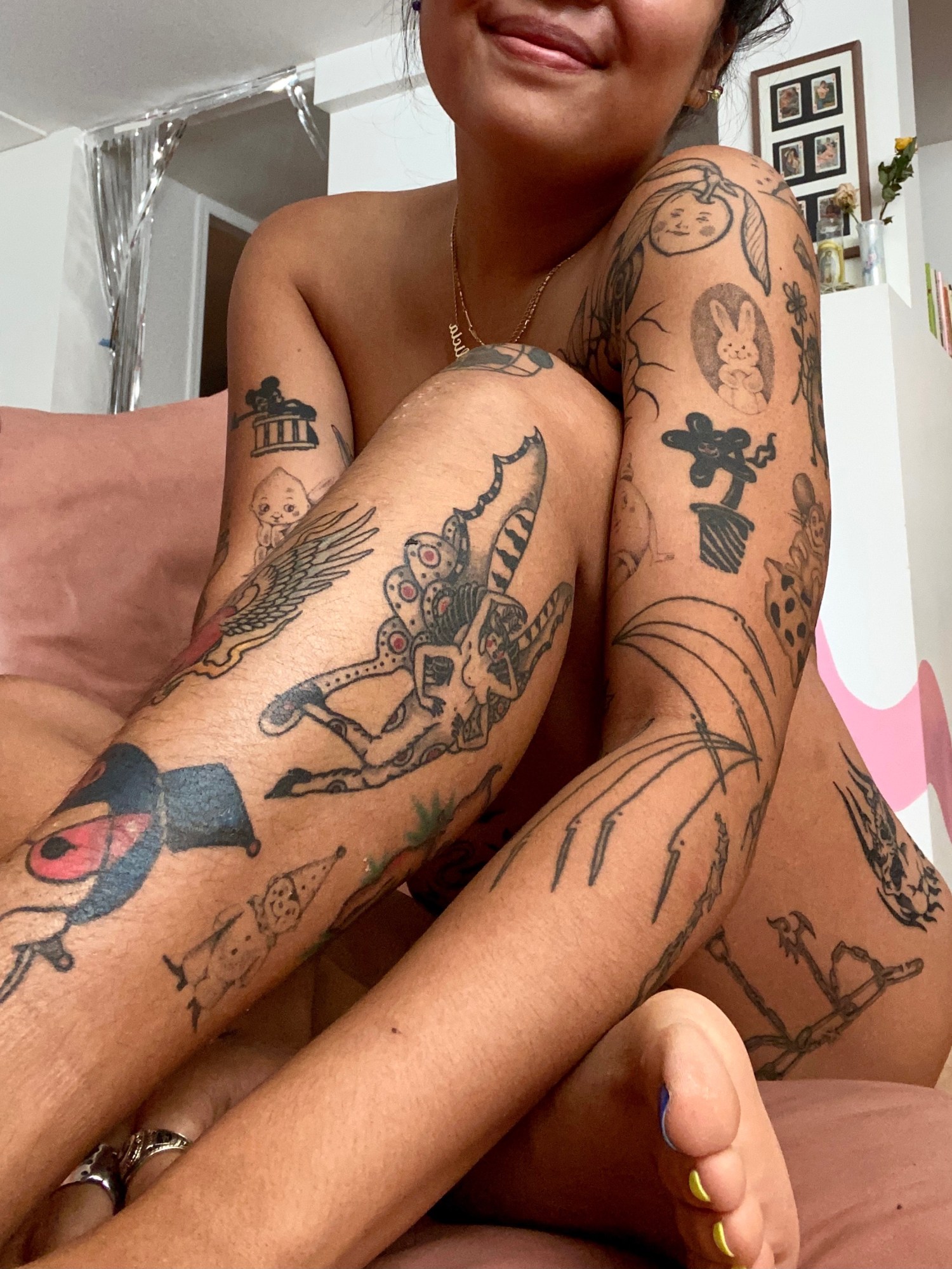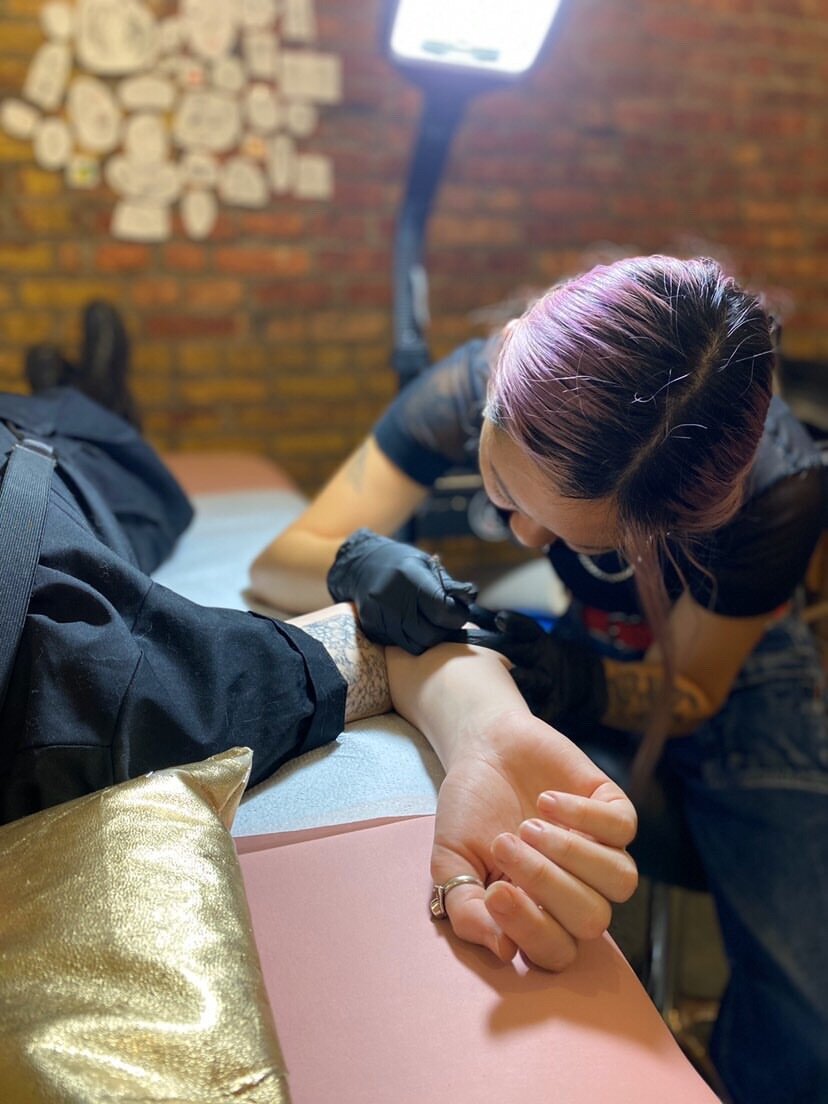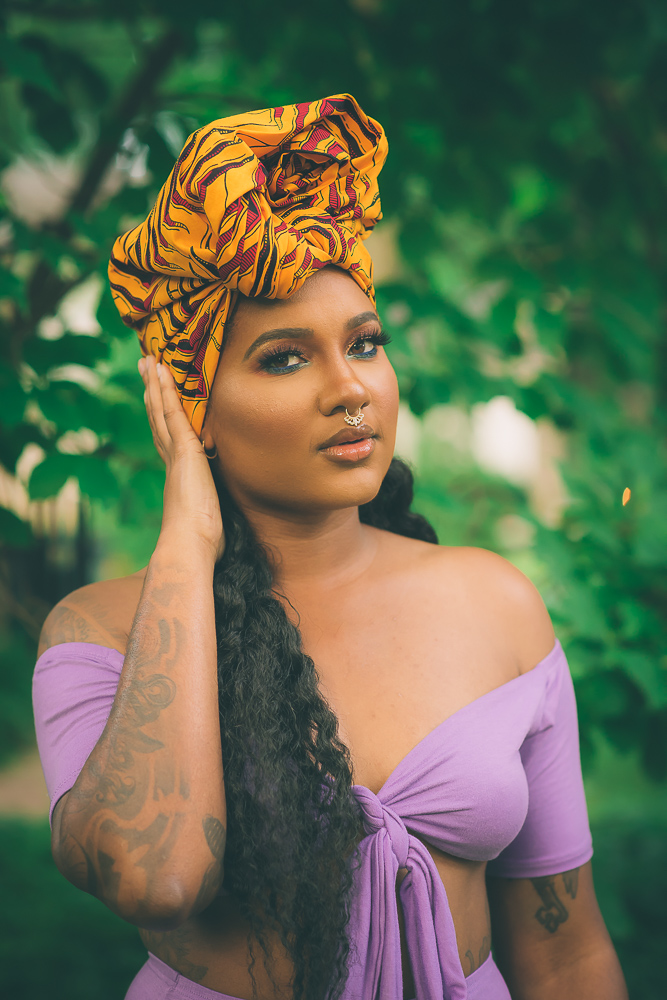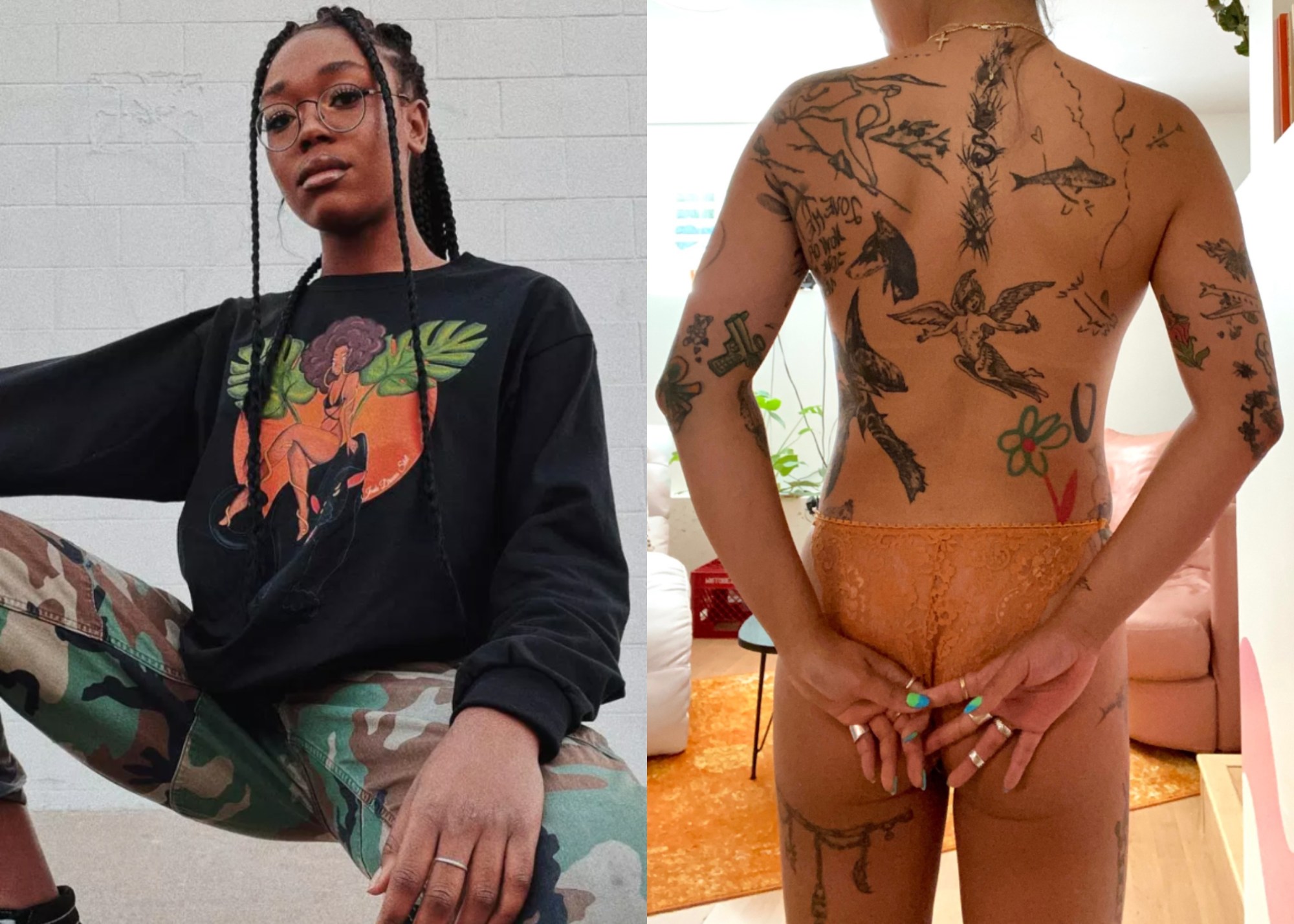Already the pandemic memorial tattoos are proliferating: soundwaves from a last voicemail before passing from Covid-19 complications; a masked nurse haloed like a deity; “I survived a global pandemic and all I got was this stupid tattoo.” But coronavirus also changed how we’re getting tattoos in less obvious ways. A year of trauma has imprinted on us ideas of solidarity and empathy, and as clients flood shops and studios — artists across the US are reporting double the inquiries and bookings compared to summer 2019 — a trauma-informed approach is taking hold.
The country’s 20,000 tattoo shops shut their doors for months, some an entire year. With reopening, they are making up for lost income and postponed appointments. Clinical counselor and trauma therapist Jordan Pickell wasn’t surprised to hear that many tattoo artists’ Instagram bios read “BOOKS CLOSED” for another reason. Not only did we experience a pandemic, but the global death count is ongoing. Survivors’ guilt and ambient anxiety are feelings that settle into the body and stay there, even if we don’t notice them. Layering the body with symbols meant to be seen is a form of resistance and an act of reclamation in the aftermath of a crisis.
“When something traumatic happens, it can shatter a person’s sense of safety or stability, the idea that the world is a just place. Tattoos communicate ‘I have changed’ or ‘My worldview has changed,’” Jordan says. “Healing from trauma is multi-layered and self-determined, meaning that you get to decide what your healing process looks like. Getting a tattoo can absolutely play a role in emotional transformation.”

“I protect myself by decorating myself. It’s armor,” says Alicia Chung, a 24-year-old art student and accountability facilitator in Vancouver, Canada. Since restrictions eased last fall, they have been getting new ink almost every week, often in private tattoo studios occupied by their growing network of friends who wield a rotary machine. A lot of their pieces don’t have any meaning, and they think they might even be stupid — a spider on their elbow, a slime gun with a halo, a sexy peanut, “fast and furious” above the crotch — but the point is Alicia chose them. “It’s my weird, twisted way of gaining autonomy.”
The sudden and total absence of autonomy is a hallmark of the pandemic era. It’s at the root of anti-masker and anti-vaxxers’ complaints. It seemed to be the central conflict — more powerful than the illness itself — of quarantine essays penned from vacation homes. Now our newfound autonomy in reopened society is stressing us out, spawning FOMO in some and fear of going out in others. Asserting self-determination has always been a reason to get tattooed, but it’s taken on new meaning in the post-pandemic landscape.
“When my studio reopened in August, I was worried people weren’t going to come,” says Ocean Gao, an artist based in Brooklyn, New York. “But more people wanted tattoos than before the pandemic. I think there was an excitement to practice agency, and I was tattooing a lot of designs that people said they had wanted for years.”
Psychologically, a period of isolation and pause can act as a values reset. “Many of us had never confronted the reality of ‘life is short,’ which inspires the ‘why not’ decision-making,” Jordan explains. For those who had leftover money from government stimulus checks after paying rent and debts, a tattoo was something exciting to spend it on.
Part of why Alicia has been under the needle so often is that the restaurant they work at temporarily closed, school went virtual and parties were cancelled. They had too much time and too little socialization. “This is the only time I can get some rest, or allow myself that rest,” they say. “It got to a point where I didn’t even mind spending the money to get all these [tattoos] because I’m paying for those four hours to be on the table and receive a professional service. We get intimate and vulnerable but it maintains this clientele relationship because I’m paying for their trust and conversation. And the isolated pain of a billion vibrations.”
As social beings, we suffered from the loss of non-pod interaction. Ocean could still sketch in lockdown if they had the energy, but couldn’t, say, chat about Miyazaki movies with a stranger while inking the bathhouse from Spirited Away on their back. (“I prefer customs these days because they’re so collaborative,” they explain.) We missed our third-tier friends, the people we lock eyes with on the subway and the professionals we paid in exchange for expertise.

“A tattoo is an experience you’ll never forget,” says Detroit artist and shop owner Krissy The Butcher, who is busier than she has ever been in her 13-year career. “You’re nervous, the adrenaline is racing. People want that feeling again. I’ve designed [my shop] so that it’s very calming, people can bring their friends… It’s got a vibe.”
Physical intimacy is a crucial part of restoration after trauma, too, according to Jordan. “Being around other people is one way that we co-regulate, meaning our bodies go back to a sense of groundedness and safety. That’s not something we really do on our own.” For artists who see themselves as healers, this understanding is top of mind.
Jude le Tronik specializes in flora and fauna — because nature was “a major healer” in their life — and exclusively does freehand blackwork out of the private studio they founded in Seattle. “Freehanding is for myself and for the client. I feel like it’s an honoring process to be fully present.” Jude, who offers free scar cover-up tattoo services to survivors of domestic or sexual violence, believes tattooers are not therapists but still must hold space for stories of internal pain that arise from their clients.
In Tamara Santibañez’s unprecedented manifesto/guidebook/love letter Could This Be Magic? Tattooing As Liberation Work, published in March and developed out of discussion groups held during the pandemic, they assert that a tattoo shop has the potential to be an important site of community building and transformation. Historically, that potential is undermined by a masculine culture lacking tenderness. There is a schism between street shops and DIY private studios, between the artists who ask for consent to shave you and artists who snap a photo of your lower back while you’re face-down, unaware. Lily, 20, knew that for her memorial tattoo for her cousin who died of suicide during quarantine, she wanted to patronize a queer-led shop and be tattooed by a non-male artist. “I just needed not to worry about someone maybe hitting on me when I was getting this done,” she says.
We are in a unique moment of systemic change and the pandemic’s effect on the future of tattoo spaces is beginning to show. For many, it’s taking a trauma-informed direction; for others, a selfish fight-or-flight. Pat Fish has been tattooing for 37 years, and she estimates that since Covid hit, the dozen tattoo studios around the Santa Barbara valley have shrunk to six. “I think all the rest of them are advertising on Craigslist that they’ll make a home visit, completely unsanitary situation. The major impact of the pandemic is people realized ‘why should I pay $380 to the health department to inspect me once a year?’ They are not taking their responsibility as an agent of change seriously.”
“The old-school thing was you were on the ground level because you want somebody randomly walking by to hear the sound, bzzzzz, and to be intrigued in the door,” Pat continues. “Now I think, ‘I don’t want you striding in, who are you?’ If I’m going to have close contact with people one-on-one, let’s have it just be them.”
Acknowledging the power dynamic between tattooer and client is necessary for a safe space. When Ocean places a stencil, for example, they tell the client it’s no big deal to move or change it, they won’t be mad. “When I was getting my first tattoos I was scared to ask for what I wanted. Even if you don’t have trauma, it’s a scary thing to go into a situation where a stranger alters your appearance forever.”
Getting tattooed has always been scarier for some people. Jade Bell is a Los Angeles tattoo artist and illustrator who grew up seeing her mom denied from shops for being a Black woman. When she did find a willing artist, they weren’t necessarily trained appropriately. “I literally watched a girl give my mom a keloid scar because she didn’t know how to work with darker skin,” Jade says.
America’s “plague year” included one of the largest protest movements in the country’s history, that led to an ongoing racial reckoning impossible to turn off. It echoed throughout the tattoo community, as Instagram infographics circulated resources for inking different skin pigments and white artists were outed for culturally appropriative flash.

“People started realizing they had no Black art in their [tattoo] collections,” Jade says. “I asked my partner, ‘Hey, can you name five Black [tattoo] artists?’ We couldn’t. ‘What about five famous tattoo models who are Black?’ We couldn’t think of any at all.”
Luckily Jade is a Virgo, so she was undaunted by the idea of changing the culture herself. “I like to see myself represented in things I love. I never saw Black women being drawn in the illustrative style that I see other women being drawn in all the time. I’m developing my own universe of four-eyed Black girls.”
Krissy The Butcher lives and works in Detroit, the largest Black-majority city in the US. Over the last year, she noticed ideas about race and society making their way onto bodies. “Tattoos help people heal from generational trauma. It causes you to research imagery represented by our ancestors. I’m seeing people get African symbols with a 2021 twist, and I’m getting to tattoo what I love and know, which is anything related to the Black female form.”
A common counter-argument is ‘Why put a reminder of your hardship on your body?’ “I’m thinking about it anyway,” says Kansas City therapist Jacey Lee. “My trauma defines a lot of who I am and I used to resent that. Now I’m actually glad [for it] because I love who I am right now.”
In February, Jacey got a bicep tattoo of a plant blooming out of a tomato can. For years, she alluded to her “fucked-up childhood” without actually addressing it. When someone described their trauma to her as a jar of rotten tomatoes that acquired more and more pressure as time went on, until the lid burst and juice splattered everywhere, Jacey transformed it into a poem. After a year of pause in which she finally stuck with therapy and did things she never allowed herself to do as a fat woman — like roller skating, wearing crop tops and considering her body a canvas — she was ready to make it a permanent reminder.
“People have experienced more trauma in the past five or so years than I think we ever have collectively. Just by going on the internet we are constantly digesting other people’s trauma,” Jacey says. “A tattoo becomes a positive part of your story.”
It’s beautiful to watch collective grief metamorphosing as we heal individually. “So much of healing from trauma involves humor, at least for me,” Alicia says. “People ask me what I’ll think of my sexy peanut tattoo in 30 years. Maybe I’ll look back and say to myself, ‘You probably could have loved yourself a little more, this was obviously your way of coping.’ I think it’s cool to have that mark of remembrance, to be a wrinkly old lady with drawings made during a crazy time in the world.”




